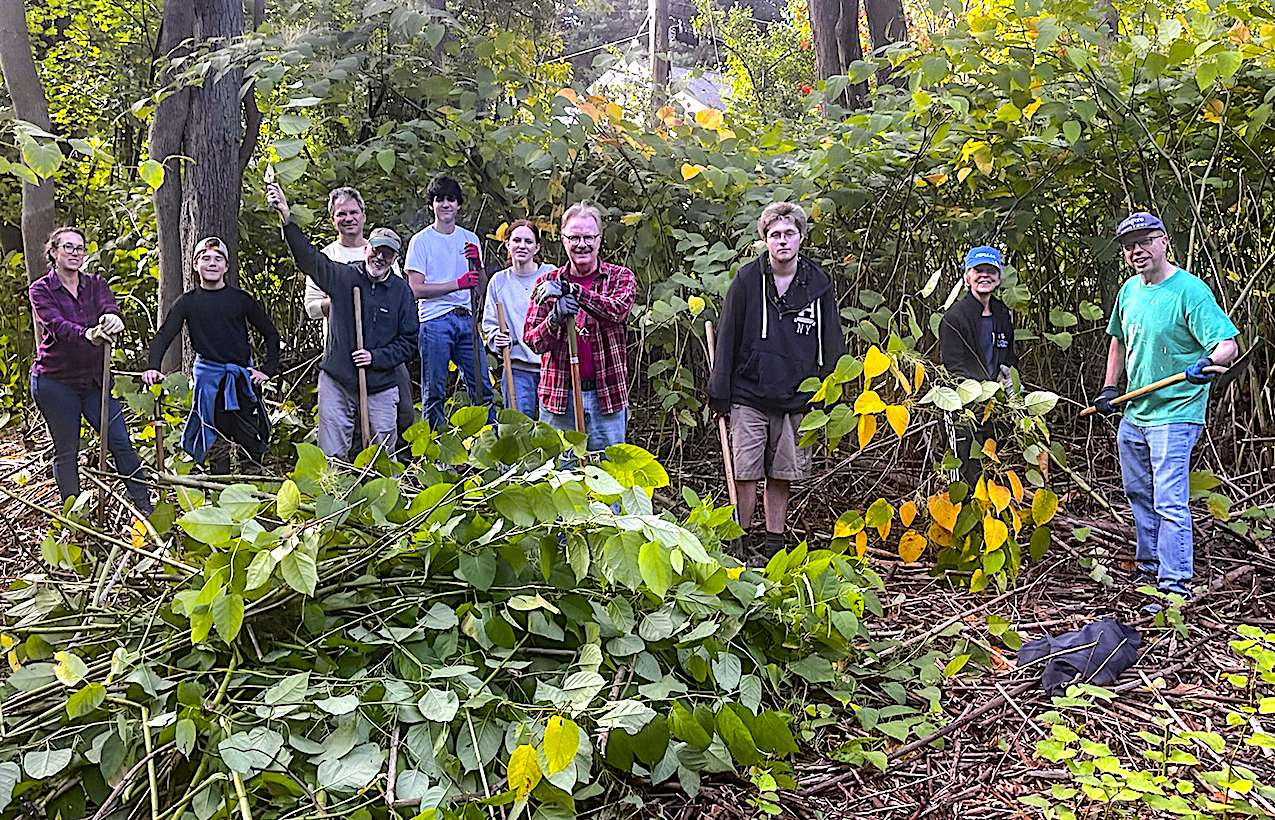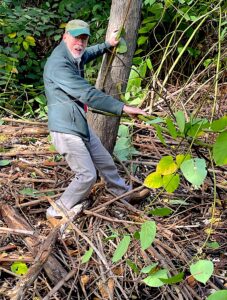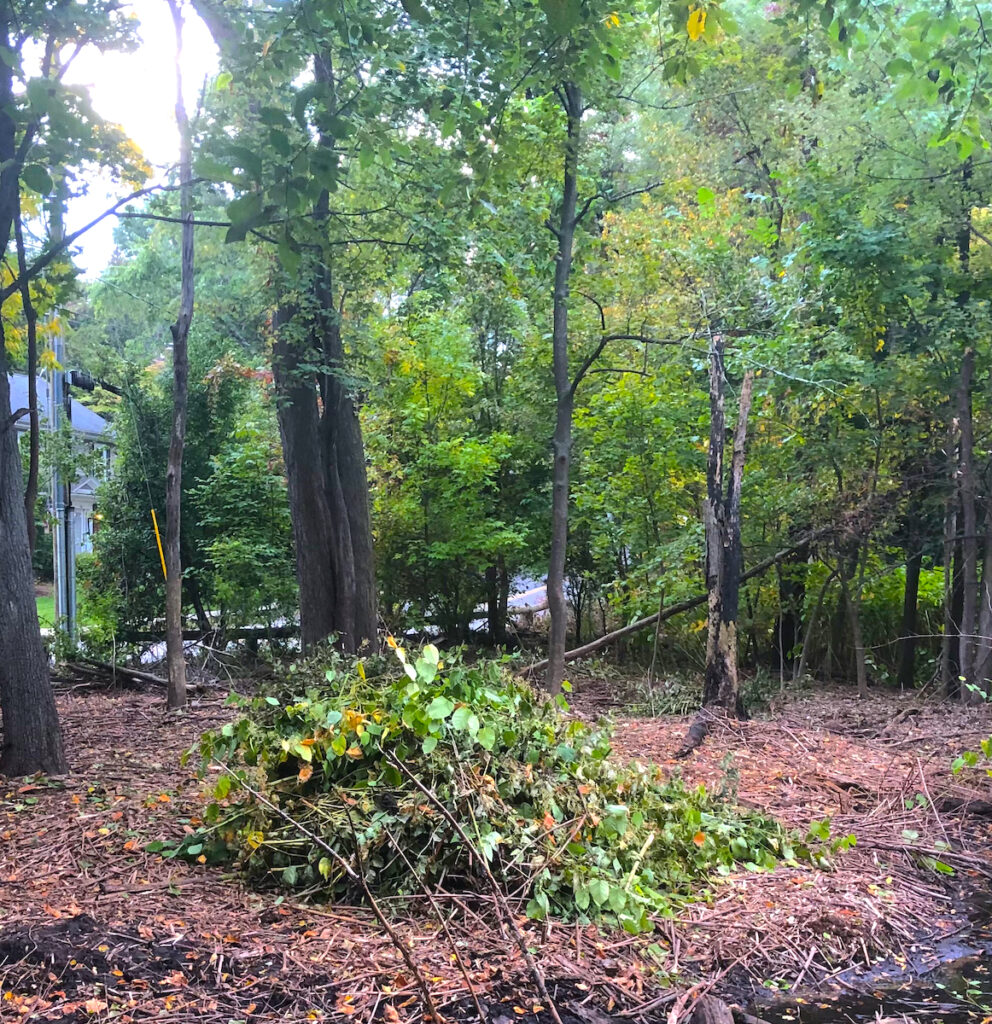By Vincent Stanton, Jr. and Pamela Andrews
Belmont Conservation Volunteers (BCV) formed earlier this year to work on “restoring our natural spaces for everyone to enjoy.” Volunteer efforts have focused on reining in the extensive and expanding invasive species displacing native plants which support local insects, birds, and mammals.
The BCV emerged from pioneering volunteer work by Leonard Katz on Lone Tree Hill. (See “Spare a Thought for Lone Tree Hill”, BCF Newsletter, September 2022.) To expand that work to town-owned land, Katz and Sustainable Belmont leader Dean Hickman obtained permission from both the Select Board and, because many of the worst infestations are near water, the Belmont Conservation Commission, which regulates activity adjacent to bodies of water. BCV committed to remove invasive plant species on a specified list from designated wetlands. The group organized and led invasive plant removal events on most weekends last summer.
BCV can provide a more comprehensive approach to the local invasive plant problem than has been possible in the past for two reasons:
BCV can address the problem in a town-wide context. That is essential because some water-loving invasive plants, like Fallopia japonica, commonly known as Japanese knotweed, can be spread by streams. It is futile to eliminate the plant downstream of an upstream colonization; the plant will quickly reseed. Since many of Belmont’s streams are fed by water from Belmont Hill, controlling the plant on Lone Tree Hill—especially near water—may have positive ripple effects. There will be less spreading and less reseeding and regrowth downstream.
BCV can provide a continuous level of effort. Invasive plants are persistent and aggressive. They cannot be controlled by one-off (often annual) cleanups, although those events are important because they marshal a large workforce to bear on the problem. The weekly events organized by BCV provide a qualitatively different level of pressure on invasive species.
The BCV group also gives participants a chance to learn about and share best practices for invasive plant control.
On Monday, October 9, the Belmont Religious Council sponsored its annual Belmont Serves volunteer event featuring four projects, including a collaboration with BCV to pick up trash and attempt to control the massive knotweed infestation at the town-owned Royal Road Woods. This underappreciated parcel of land is a minute from Belmont Center and seconds from the 74/75 bus stop and the Belmont Center commuter rail station. It could be an attractive pocket park featuring a pond drained by a small stream, but all that has been hidden, that is, buried.

Belmont Serves Royal Road knotweed crew. From let fo right: Caroline Newton, Teddy Newton, Karsten Kueppenbender, Vince Stanton, Owen Thomas, Jane Quigley, John Little, Jeremy Broitman, Molly Aalyson, and Eric Wefald. Photo: Janet Sands
The knotweed infestation is densest around the water at the bottom of Royal Road, where there is a roughly 150 by 70 square foot stand of 8 to 10-foot high stalks. This knotweed has displaced all other plant life save for a few old trees. That zone was targeted for knotweed clearance. The approach was to sever the stalks at the base. At this time of year, the plant sends energy down to its massive underground root system (rhizomes). Interrupting that energy flow weakens the plant.
About a dozen energetic volunteers used shovels to clear a 75- by 50-foot area of knotweed, and the plants were piled up and left to decompose on site. In the newly cleared zone, it was possible to observe the course of the stream that originates opposite 14 Royal Road. It runs east along the railroad embankment before curling south toward Royal Road, where it enters an underground pipe that empties into the storm drain. Note that this stream is not Wellington Brook, which is confined in a 6-foot underground pipe that crosses under Royal Road uphill of the pond and stream. (See “Whither the Royal Road Woods?,” BCF Newsletter, January 2022, for a map).
Any serious effort to control knotweed requires a long-term strategy. Here are three strategies in decreasing order of time and labor required for implementation.
- Cutting knotweed to the ground multiple times each year. That cutting starves the plant of energy, which is created by photosynthesis in the leaves during the summer and stored in the rhizomes over the winter. This is the approach BCV employed on October 9.
- Clearing knotweed (optionally including excavation of the root system), flattening it the ground, and then covering it with a heavy geotextile (synthetic fabric) designed to block out sunlight and prevent vertical growth.
- Applying herbicide (usually glyphosate, sold under the brand name RoundUp) to the leaves (via foliar spraying) or stems (via direct injection) once a year in the fall, when the vascular system of the plant is sending energy down to the rhizomes.
There are numerous reports about each method, but only a few controlled studies. In one interesting local study, described in a report published in the Ecological Landscape Alliance newsletter, the three methods were tested for up to six years. There were two worksites; the first was a dense knotweed infestation along the Minuteman Bikeway in Lexington as it skirts Arlington’s Great Meadows, where the first two methods were implemented by volunteers under the aegis of Friends of Arlington’s Great Meadows.
The second worksite was along I-290 in Worcester, where Massachusetts Department of Transportation landscapers used stalk injection or foliar application of glyphosate to eliminate knotweed while simultaneously planting switchgrass to provide competition. While neither of the methods was a complete success by the end of the study period (up to six years along the bike path, two years in Worcester), each had brought about a significant reduction in the knotweed infestation and was on a plausible path to complete control with further effort.
The level of volunteer effort for the first approach was massive—the US Department of Agriculture (USDA) Forest Service recommends cutting the stalks to the ground at least six times per year—and would need to continue for longer than six years. Method 2 was labor intensive for a short period when the ground was prepared and the geotextile installed. Removal after one year proved insufficient to control the knotweed. Removal after three years was much better, but some viable knotweed rhizomes remained. The USDA recommends leaving the geotextile in place for up to five years. A variant of the geotextile method, described in an informative YouTube video by a wildlife specialist at the University of New Hampshire Cooperative Extension, entails placing wood chips and mulch over the geotextile and starting anew, leaving the rhizomes permanently buried. However, even this method required two extra years of patching breaches in the geotextile.
The application of glyphosate appears to be the consensus recommendation, as it is the only method that attacks the rhizomes and is, therefore, more efficient and requires less labor. Notably, several conservation organizations, including Mass Audubon, recommend the application of glyphosate to control knotweed.
The use of herbicides near wetlands requires permission of the Conservation Commission and would typically be implemented professionally. So, while the herbicide application is a quicker approach, it would likely cost more.
One final challenge: the knotweed infestation is not confined to town land but extends onto contiguous MBTA property along the steep embankment next to the Fitchburg Line.
Getting involved
Anyone can join the Belmont Conservation Volunteers. As the group points out on its website, their weekend projects offer an opportunity to get outside, exercise, meet your neighbors, and learn more about local plants while helping to restore our public lands. The easiest way to get involved is to join the BCV Google group by sending an email expressing interest to belmontconservationvolunteers@gmail.com or visiting www.sustainablebelmont.net/belmont-conservation-volunteers
Vincent Stanton, Jr. is a Belmont Citizens Forum board member. Pamela Andrews is a Belmont resident.




Sorry, the comment form is closed at this time.